中国八大菜系外文翻译
- 格式:docx
- 大小:15.93 KB
- 文档页数:3
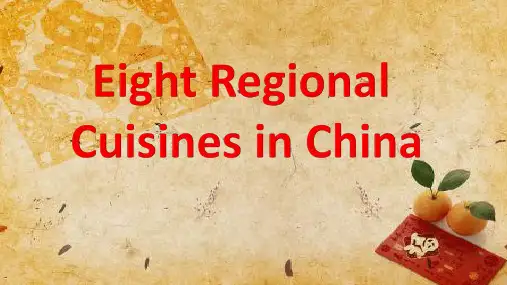

八大菜系英文介绍以下是八大菜系的英文介绍:1. 鲁菜:Shandong Cuisine, also known as Lu Cuisine, is the representative cuisine of the North and Northeast China, with a focus on seafood, pork, and chicken. It is known for its simple cooking methods, fresh ingredients, and rich flavors.2. 川菜:Sichuan Cuisine, also known as Chuan Cuisine, is a spicy and pungent cuisine from Sichuan Province in China. It is famous for its fiery peppers and rich sauces, and often features pork, chicken, and seafood.3. 粤菜:Cantonese Cuisine is the representative cuisine of Guangdong Province in China, known for its freshness, simplicity, and unique seasonings. It emphasizes the use of high-quality ingredients and pays attention to the presentation of dishes.4. 闽菜:Fujian Cuisine is a coastal cuisine from Fujian Province in China. It emphasizes seafood, fresh vegetables, and rice dishes. The cooking methods are unique, with a focus on stewing, steaming, and deep-frying.5. 苏菜:Jiangsu Cuisine is a representative cuisine of the Yangtze River Delta region in China. It emphasizes freshness, tenderness, and mild flavors. The cooking methods are diverse, including stewing, steaming, frying, and braising.6. 浙菜:Zhejiang Cuisine is a representative cuisine of the eastern region of China, known for its simplicity and unique flavors. It often features rice dishes, seafood, and various kinds of meat. The cooking methods include stewing, steaming, and frying.7. 湘菜:Xiang Cuisine is a spicy and pungent cuisine from Hunan Province in China. It emphasizes the use of fresh ingredients and fiery peppers, often featuring pork, chicken, and beef. The cooking methods include stewing, steaming, and deep-frying.8. 徽菜:Anhui Cuisine is a traditional Chinese cuisine from Anhui Province, known for its unique flavors and seasonings. The main ingredients include pork, chicken, duck, and various kinds of vegetables. The cooking methods include stewing, steaming, frying, and braising.。
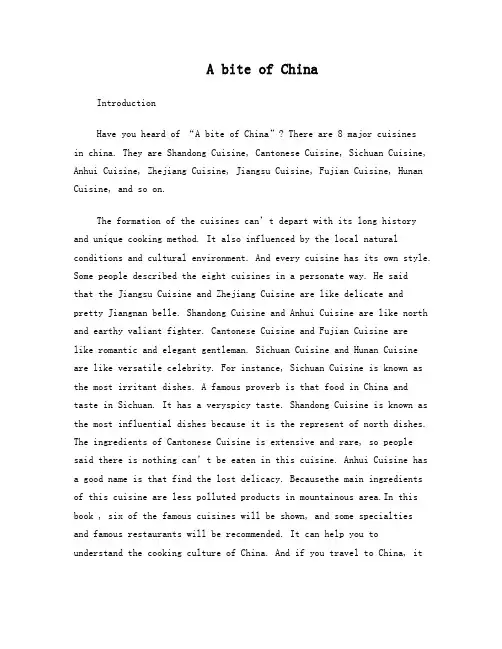
A bite of ChinaIntroductionHave you heard of “A bite of China”? There are 8 major cuisinesin china. They are Shandong Cuisine, Cantonese Cuisine, Sichuan Cuisine, Anhui Cuisine, Zhejiang Cuisine, Jiangsu Cuisine, Fujian Cuisine, Hunan Cuisine, and so on.The formation of the cuisines can’t depart with its long history and unique cooking method. It also influenced by the local natural conditions and cultural environment. And every cuisine has its own style. Some people described the eight cuisines in a personate way. He saidthat the Jiangsu Cuisine and Zhejiang Cuisine are like delicate andpretty Jiangnan belle. Shandong Cuisine and Anhui Cuisine are like north and earthy valiant fighter. Cantonese Cuisine and Fujian Cuisine arelike romantic and elegant gentleman. Sichuan Cuisine and Hunan Cuisine are like versatile celebrity. For instance, Sichuan Cuisine is known as the most irritant dishes. A famous proverb is that food in China and taste in Sichuan. It has a veryspicy taste. Shandong Cuisine is known as the most influential dishes because it is the represent of north dishes. The ingredients of Cantonese Cuisine is extensive and rare, so people said there is nothing can’t be eaten in this cuisine. Anhui Cuisine has a good name is that find the lost delicacy. Becausethe main ingredients of this cuisine are less polluted products in mountainous area.In this book , six of the famous cuisines will be shown, and some specialtiesand famous restaurants will be recommended. It can help you to understand the cooking culture of China. And if you travel to China, itcan help you to choose your favorite food. So you can have a cate enjoyment. Now, let’s open the gate of Chinese Cuisines.Shandong Cuisine (July)Shandong Cuisine, which is originated from Shandong flavor, always clean, pure, and not greasy. Shallot and garlic are two main seasonings of the dishes, so Shandong Cuisine usually tastes pungent. It emphasizes on tenderness, crispness and freshness. Jinan cuisine and jiaonan cuisine are the two main parts of Shandong Cuisine. Jinan cuisine characterizes by deep-frying and stir-frying, grilling, and stir-frying while jiaonan cuisine focuses on cooking food with light taste. Soups are very famous in Shandong Cuisine. If you have a try, you will find that thin soup tastes fresh and creamy soup tastes strong.Shandong is the birthplace of cooking culture, and there ever existed many famous ancient scholars, such as Confucius and Mencius. As old as the ancient scholars, Shandong Cuisine also has a long history. It originated in the Spring and Autumn period , and formed during Qin and Han Dynasty. After Song Dynasty, it became the represent of “the North dishes”. Shandong cuisine is one of the major eight Chinese cuisine and it is the local cuisine that covered most extensive area in China, include Beijing, Tianjin and Dongbei Province.Shandong Province is known as the origination of ancient culture in China. The formation of Shandong Cuisine has a tight connection with the local history, geographical conditions, economic conditions and customs. This province is also known as one of world’s three gardens. For example, jiaozhouChinese cabbage, Zhangqiu garlic, Cangshan shallot are famous in abroad.There are too many Shandong Cuisine restaurants in china. The most famous restaurants includeQilurenjia, Beijing Qilu Restaurant and Tongheju.Cantonese Cuisine(Asiya)Cantonese Cuisine is one of the eight culinary traditions of Chinese cuisine. When westerners speak of Chinese food, they usually refer to Cantonese Cuisine. Why? This is because of the most Chinese who immigrant and set up restaurants overseas were from Guangdong. Now, let me introduce this kind of cuisine. Guangzhou, the capital of Guangdong province, has long been a trading port and many important food. Unlike other Chinese cuisine style of cooking, Cantonese Cuisine more attention to bring out or highlight the original taste of the meet, vegetable. unlike Sichuan Cuisine so spicy, unlike other foods lost original taste of cooking, so Cantonese Cuisine is a little spice or sugar is used generally.Common Cantonese Dishes for you.These dishes are often simple and easy to learn to cook, and they came the most common foods on the menus of Cantonese restaurants.Chinese steamed eggs: there are by beating eggs to a creamy consistency and steaming till this water boiling. Variations are derived by colding different ingredients, such as onion and soy sauce.Noddle dishesShahe noodles are a kind of rice noodles, they are broad and look white, their texture is elastic and like a little chewy. They don’t freeze or drying and should generally purchased fresh in strips that should be cut to the desired width. Shahe noodles are popular in southern china.Meat Dishes.We should boil the chicken in water until the chicken looks golden. When it is cook done, the chicken tastes fresh and maintain original taste of chicken.Seafood.Because Guangdong located on the southern of china, fresh seafoodis easy to available to get and many Cantonese restaurants are best use of this advantages. In Cantonese culinary arts, steaming is best cooking style. According to Cantonese Cuisine, the taste fresh is the most important point, so seafood generally cooked by steaming.Cantonese are known to us that they try different kind of meats and vegetables. So, people those who are in Northern China often says that Cantonese people will eat anything that flies except airplanes, anything that moves on the ground except train, and everything that moves in the water except boats.Panxirestaurant in Guangzhou.Address: 151 west longjin road, Liwan District. Lung king HeenAddress: IFC Tower, 8 Finance st, Hong Kong.Zhejiang cuisine(Clark)Zhejiang cuisine also called ZheCai for short, is one of the eight major cuisines of China. Zhejiang cuisine has it’s unique taste and uniquecooking method. It’s because that Zhejiang province be rich in natural resources. Zhejiang province closed to sea, so Zhejiang cuisine is good at making sea food, and Zhejiang province also is the main place that product meat and rice, so the meat also is the Zhejiang cuisine’s material. So Zhejiang cuisine’s cooking methods mainly are sautéing, stir-frying, simmering and steaming, obtaining the natural flavor and taste. Zhejiang cuisine, not greasy, wins its reputation for freshness, tenderness and smoothness of its dishes with mellow fragrance.Zhejiang cuisines include Hangzhou food, Ningbo food and Shaoxing food. Hangzhou, Ningbo and Shaoxing are all in ZhejiangProvince. Hangzhou food is the most famous cuisine in the Zhejiang cuisine.Hangzhoufood tastes fresh and crisp, and with the change of season it also has different kinds of food. And the main cooking methods of Hangzhou food are sautéing stewing, deep-frying and steaming. Ningbo food is a bit salty but delicious. And Ningbo food is good at steaming,roasting and braising seafood, so Ningbo food famous by retaining original freshness, tenderness and softness. Shaoxing food known asit’s aquatic food and poultry. Sha oxing food has a unique village flavor, smell sweet taste soft and glutinous, thick in gravy and strong in season.Zhejiang cuisine specializes in stir-frying, steaming, deep-frying and simmering, obtaining the natural flavor and taste. And Zhejiang province has full of materials, and people take special care in cooking, so Zhejiang cuisine is so delicious and be famous in China.Anhui Cuisine (Angenla)Anhui cuisine, together with Shan dong cuisine, Sichuan cuisine, Cantonese cuisine, Zhejiang cuisine and Jiangsu cuisine are all belonged to Chinese royal dishes from Qin dynasty. They all pay attention to the cultured colors and fresh materials.It is said that the emperor Yuan collected public opinions from Anhui and Zhejiang provinces when he unified southern China in 221B、C. He happened to be invited to a village when he passes by Anhui province. Although the villagers did not recognize his identify, they treated him with generous hospitality and did him a meal with fresh seafood and home-made chili sauce. When the emperor Yuan came back to the capital, he missed that taste and the people there. To memorize villagers’ kindness and this moved experience, he named it Hui cuisine and listed Anhui cuisine as one of the eight major components of Chinese cuisine.The most famous dish of Anhui cuisine called “Boiled fish”. They put the raw fish into boiled chili oil and add green onion, ginger, garlic and soy to it. Wait your raw ingredients are slow-cooked in a safe, enclosed cooker for 20minutes and a delicious boiled fish is born!Have a taste, you can feel the fish with hot sauce is melted in your mouth.Southern cuisines like to use seafood and chilies to make the foods have strong taste. Similarly,traditional Anhui cuisine as a part of southern cuisine also use fierce ingredients to awakening thegastricfire .On completely contrast, northern cuisine ,like Shandong cuisine are light and use chilies and pepper as less as they can.However, because of the big differences between southern cuisines and northern cuisines, Chinese dietary culture appears to be rich and varied.Jiangsu Cuisine(Belle)Jiangsu cuisine, which is abbreviated to su cuisine, is one of the eight cuisines of Chinese mainly nationality. It was invented two thousand years ago. Jiangsu cuisine is similar to the Zhejiang cuisine. They are both also called the land of fish and rice because of the much water there. Jiangsu province and Zhejiang province are located in the south of China and beside the sea, so there are a lot of rainfall in Jiangsu and Zhejiang. Therefore, some delicious food is made of fish in Jiangsu and Zhejiang province. On the other hand, Jiangsu cuisine is different from Zhejiang and the other places. Its characteristic is thick with light, crisp and fresh juice broth strong but not greasy, gentle, salty and sweet. The cookers in Jiangsu are good at stewing, braising, burning, heating and frying. In addition, they are skilled in cooking soup that taste very fresh. What is the most representative are Suzhou dish, Yangzhou dish, Nanjing dish and Zhenjiang dish. Suzhoufood taste sweet and its color slants harmony. Yangzhou cuisine haslight material, fine mellow flavor and knife labor. Nanjing and Zhejiang dish focus on alcohol which make the dishes have exquisite dainty, especially in the prestigious duck dishes. In a word, Jiangsu cuisine is famous for its colorful selection of ingredients, its meticulous preparation methodology and its not-too- bland taste.。
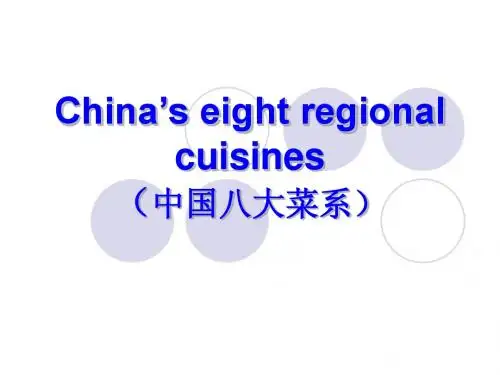
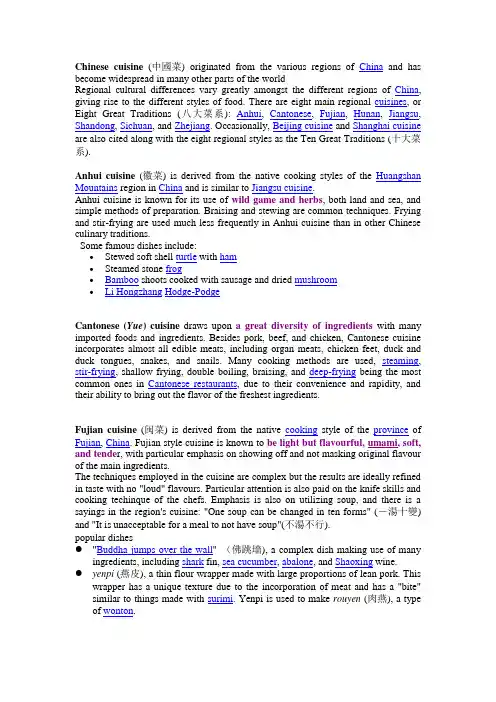
Chinese cuisine(中國菜) originated from the various regions of China and has become widespread in many other parts of the worldRegional cultural differences vary greatly amongst the different regions of China, giving rise to the different styles of food. There are eight main regional cuisines, or Eight Great Traditions (八大菜系): Anhui, Cantonese, Fujian, Hunan, Jiangsu, Shandong, Sichuan, and Zhejiang. Occasionally, Beijing cuisine and Shanghai cuisine are also cited along with the eight regional styles as the Ten Great Traditions (十大菜系).Anhui cuisine(徽菜) is derived from the native cooking styles of the Huangshan Mountains region in China and is similar to Jiangsu cuisine.Anhui cuisine is known for its use of wild game and herbs, both land and sea, and simple methods of preparation. Braising and stewing are common techniques. Frying and stir-frying are used much less frequently in Anhui cuisine than in other Chinese culinary traditions.Some famous dishes include:∙Stewed soft shell turtle with ham∙Steamed stone frog∙Bamboo shoots cooked with sausage and dried mushroom∙Li Hongzhang Hodge-PodgeCantonese (Yue) cuisine draws upon a great diversity of ingredients with many imported foods and ingredients. Besides pork, beef, and chicken, Cantonese cuisine incorporates almost all edible meats, including organ meats, chicken feet, duck and duck tongues, snakes, and snails. Many cooking methods are used, steaming, stir-frying, shallow frying, double boiling, braising, and deep-frying being the most common ones in Cantonese restaurants, due to their convenience and rapidity, and their ability to bring out the flavor of the freshest ingredients.Fujian cuisine(闽菜) is derived from the native cooking style of the province of Fujian, China. Fujian style cuisine is known to be light but flavourful, umami, soft, and tende r, with particular emphasis on showing off and not masking original flavour of the main ingredients.The techniques employed in the cuisine are complex but the results are ideally refined in taste with no "loud" flavours. Particular attention is also paid on the knife skills and cooking techinque of the chefs. Emphasis is also on utilizing soup, and there is a sayings in the region's cuisine: "One soup can be changed in ten forms" (-湯十變) and "It is unacceptable for a meal to not have soup"(不湯不行).popular dishes●"Buddha jumps over the wall" (佛跳墙), a complex dish making use of manyingredients, including shark fin, sea cucumber, abalone, and Shaoxing wine.●yenpi (燕皮), a thin flour wrapper made with large proportions of lean pork. Thiswrapper has a unique texture due to the incorporation of meat and has a "bite"similar to things made with surimi. Yenpi is used to make rouyen (肉燕), a type of wonton.Hunan cuisine, sometimes called Xiang cuisine(湘菜) is well known for its hot spicy flavor, fresh aroma and deep color. Common cooking techniques include stewing, frying, pot-roasting, braising, and smoking. Due to the high agricultural output of the region, ingredients for Hunan dishes are many and varied.A special hot pot called (鸳鸯火锅yuān yāng hǔo gūo) lover's hot pot is famous for splitting the pot into a spicy side and a milder side.∙Dongan chicken∙Mao's braised pork∙Changsha vermicelli∙Steamed fish heads in chili sauce∙Orange beef∙Hot and peppery chicken∙Spare ribs steamed in bamboo∙Changsha-style stinky tofu∙Mashed shrimp in lotus pod∙Xiangdu roast duck∙Sizzling rice soup∙Lotus Seeds in rock sugar syrup∙Pumpkin cake∙Spicy frog leg∙Oxtail porridgeJiangsu cuisine (苏菜) In general, Jiangsu cuisine's texture is characterized as soft, but not to the point of mushy(糊状的)or falling apart. For example, the meat tastes so soft but would not separate from the bone when being picked up. Other characters includes the strict selection of ingredients according to the seasons, emphasis on the matching color and shape of each dish and emphasis on using soup to improve the flavor. Suzhou cuisine: emphasis on the selection of material, stronger taste than Nanjing cuisine, and with a tendency to be sweeter than the other varieties of the cuisine.Shandong cuisine (鲁菜) Shandong cuisine consists of two major styles:Jiaodong style: This style encompasses dishes from Fushan, Qingdao, Yantai and surrounding regions. It is characterized by seafood cooking, with light tastes.Jinan style: This style encompasses dishes from Jinan, dezhou, Tai'an and surrounding regions. It is famed for its soup and utilizing soups in its dishes.Sichuan cuisine (川菜) is famed for bold flavors, particularly the spiciness resulting from liberal use of chilis and "numb" or "tingling" flavor (Chinese: 麻) of the Sichuan peppercorn (花椒). Szechuan cuisine often contains food preserved through pickling, salting, drying and smoking, and is generally spicy. The Sichuan peppercorn is commonly used; Broad bean chili paste (豆瓣醬)is also a staple seasoning in Sichuan cuisine.Common preparation techniques in Sichuan cuisine include stir frying, steaming and braising, but a complete list would include more than 20 distinct techniques. Beef issomewhat more common in Szechuan cuisine than it is in other Chinese cuisines, perhaps due to the widespread use of oxen in the region.Kung Pao chicken宮保雞丁Twice Cooked Pork回鍋肉Fuqi Feipian夫妻肺片Zhejiang cuisine(浙菜) Food made in the Zhejiang style is not greasy, having instead a fresh and soft flavor with a mellow fragrance.The cuisine consists of at least three styles, each originating from a city in the province: the Hangzhou style is characterized by rich variations and the utilization of bamboo shoots, the Shaoxing style specializes in poultry and freshwater fish, and the Ningbo style specializing in seafood, with emphasis on freshness and salty dishes.Some sources also include the Wenzhou style as a separate subdivision, characterized as the greatest source of seafood as well as poultry and livestock. Ningbo cuisine is regarded as rather salty.Dongpo rou, Jiaohua ji(beggar's chicken) and Xi Hu cu yu(West Lake fish in vinegar)。
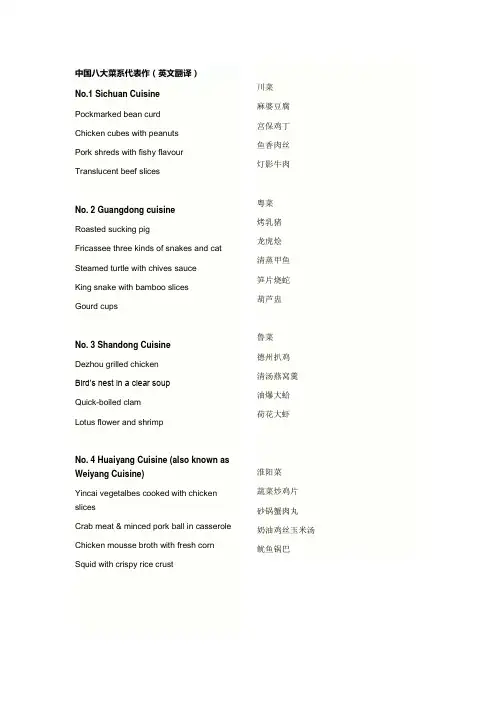
中国八大菜系代表作(英文翻译)No.1 Sichuan CuisinePockmarked bean curdChicken cubes with peanutsPork shreds with fishy flavour Translucent beef slicesNo. 2 Guangdong cuisineRoasted sucking pigFricassee three kinds of snakes and cat Steamed turtle with chives sauceKing snake with bamboo slicesGourd cupsNo. 3 Shandong CuisineDezhou grilled chickenBird’s nest in a clear soupQuick-boiled clamLotus flower and shrimpNo. 4 Huaiyang Cuisine (also known as Weiyang Cuisine)Yincai vegetalbes cooked with chicken slicesCrab meat & minced pork ball in casserole Chicken mousse broth with fresh corn Squid with crispy rice crust 川菜麻婆豆腐宫保鸡丁鱼香肉丝灯影牛肉粤菜烤乳猪龙虎烩清蒸甲鱼笋片烧蛇葫芦盅鲁菜德州扒鸡清汤燕窝羹油爆大蛤荷花大虾淮阳菜蔬菜炒鸡片砂锅蟹肉丸奶油鸡丝玉米汤鱿鱼锅巴No. 5 Zhengjiang CuisineDong po porkWest lake vinegar fishShelled shrimps with dragon well tea leavesBeggar’s chicken( a whole chicken roasted in a caked mud)No. 6 Fujian cuisineSea food and poultry in casserole Steamed chicken ball with egg-whiteFried prawn shaped as a pair of fishCrisp pomfret with litchiNo.7 Hunan CuisineDong’an chickenBraised dried pork with eel slicesSteamed turtleSpring chicken with cayenne pepperNo. 8 Anhui CuisineHuangshan stewed pigeonGourd duckFricassee pork sinew with egg whiteCrisp pork with pine nuts 浙菜东坡肘子西湖醋鱼龙井虾肉叫花鸡闽菜红烧鱼翅芙蓉鸡丸油炸对虾荔枝鲳鱼湘菜东安鸡红烧肉清蒸海龟辣子鸡丁徽菜黄山醉鸽葫芦鸭蛋花炖肉松仁排骨。
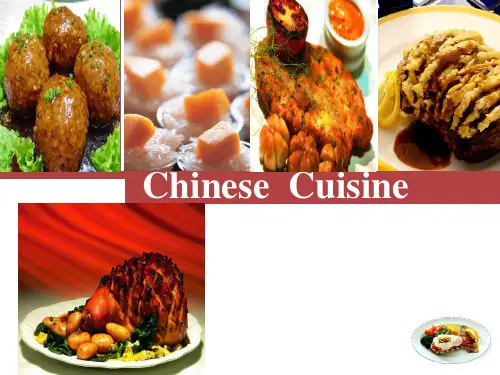
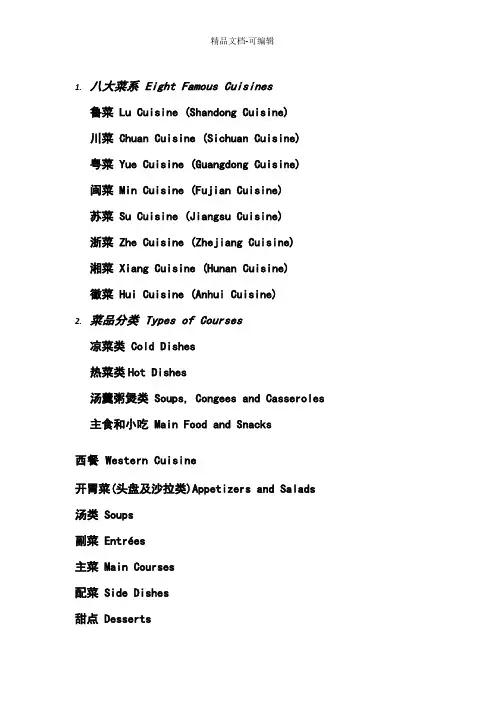
1.八大菜系 Eight Famous Cuisines鲁菜 Lu Cuisine (Shandong Cuisine)川菜 Chuan Cuisine (Sichuan Cuisine)粤菜 Yue Cuisine (Guangdong Cuisine)闽菜 Min Cuisine (Fujian Cuisine)苏菜 Su Cuisine (Jiangsu Cuisine)浙菜 Zhe Cuisine (Zhejiang Cuisine)湘菜 Xiang Cuisine (Hunan Cuisine)徽菜 Hui Cuisine (Anhui Cuisine)2.菜品分类 Types of Courses凉菜类 Cold Dishes热菜类Hot Dishes汤羹粥煲类 Soups, Congees and Casseroles 主食和小吃 Main Food and Snacks西餐 Western Cuisine开胃菜(头盘及沙拉类)Appetizers and Salads 汤类 Soups副菜 Entrées主菜 Main Courses配菜 Side Dishes甜点 Desserts饮品Drinks一、酒精类饮品 Alcoholic Beverages1. 国酒 Chinese Wines2. 洋酒 Imported Wines白兰地与威士忌 Brandy and Whisky金酒与朗姆酒 Gin and Rum伏特加与龙舌兰 Vodka and Tequila利口酒和开胃酒 Liqueurs and Aperitifs红酒 Red Wine二、不含酒精类饮品 Non-Alcoholic Beverages三、中国饮品文化 Chinese Drinking Culture1. 中国茶文化 Chinese Tea Culture2. 中国酒文化 Chinese Wine Culture一.翻译原则1以主料为主,配料或配汁为辅的翻译原则1.菜肴的主料和配料主料(名称/形状)+with+配料如:松仁香菇Chinese Mushrooms with Pine Nuts2.菜肴的主料和配汁主料with /in+汤汁(Sauce)如:冰梅凉瓜Bitter Melon in Plum Sauce2二.以烹制方法为主,原料为辅的翻译原则1.菜肴的做法和主料做法(动词过去分词)+主料(名称/形状)如:拌双耳 Tossed Black and White Fungus2.菜肴的做法、主料和配料做法(动词过去分词)+主料(名称/形状)+配料如:豌豆辣牛肉 Sautéed Spicy Beef and Green Peas3.菜肴的做法、主料和汤汁做法(动词过去分词) + 主料(名称/形状)+with /in+汤汁如:川北凉粉 Tossed Clear Noodles with Chili Sauce三.以形状、口感为主,原料为辅的翻译原则1.菜肴形状或口感以及主配料形状/口感+ 主料如:玉兔馒头Rabbit-Shaped Mantou脆皮鸡 Crispy Chicken2.菜肴的做法、形状或口感、做法以及主配料做法(动词过去分词)+ 形状/口感 + 主料 + 配料如:小炒黑山羊 Sautéed Sliced Lamb with Pepper and Parsley3以人名、地名为主,原料为辅的翻译原则1.菜肴的创始人(发源地)和主料人名(地名)+ 主料如:麻婆豆腐 Mapo Tofu (Sautéed Tofu in Hot and Spicy Sauce)广东点心 Cantonese Dim Sum4.介绍菜肴的创始人(发源地)、主配料及做法做法(动词过去式)+ 主辅料+ 人名/地名+ Style如:四川辣子鸡Spicy Chicken, Sichuan Style北京炸酱面 Noodles with Soy Bean Paste, Beijing Style5体现中国餐饮文化,使用汉语拼音命名或音译的翻译原则 1.具有中国特色且被外国人接受的传统食品,本着推广汉语及中国餐饮文化的原则,使用汉语拼音。
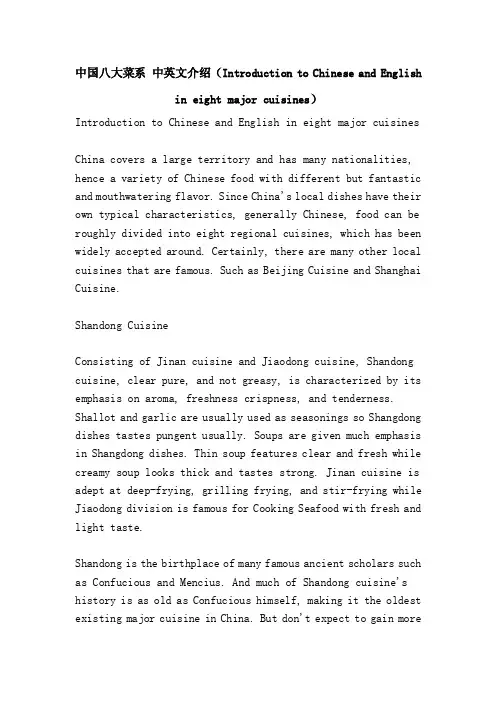
中国八大菜系中英文介绍(Introduction to Chinese and Englishin eight major cuisines)Introduction to Chinese and English in eight major cuisinesChina covers a large territory and has many nationalities, hence a variety of Chinese food with different but fantastic and mouthwatering flavor. Since China's local dishes have their own typical characteristics, generally Chinese, food can be roughly divided into eight regional cuisines, which has been widely accepted around. Certainly, there are many other local cuisines that are famous. Such as Beijing Cuisine and Shanghai Cuisine.Shandong CuisineConsisting of Jinan cuisine and Jiaodong cuisine, Shandong cuisine, clear pure, and not greasy, is characterized by its emphasis on aroma, freshness crispness, and tenderness. Shallot and garlic are usually used as seasonings so Shangdong dishes tastes pungent usually. Soups are given much emphasis in Shangdong dishes. Thin soup features clear and fresh while creamy soup looks thick and tastes strong. Jinan cuisine is adept at deep-frying, grilling frying, and stir-frying while Jiaodong division is famous for Cooking Seafood with fresh and light taste.Shandong is the birthplace of many famous ancient scholars such as Confucious and Mencius. And much of Shandong cuisine's history is as old as Confucious himself, making it the oldest existing major cuisine in China. But don't expect to gain morewisdom from a fortune cookie at a Shandong restaurant in the West since fortune cookies aren't even indigenous to China.Shandong is a large peninsula surrounded by the sea to the East and the Yellow River meandering through the center. As a result, seafood is a major component of Shandong cuisine. Shandong's most famous dish is the Sweat and Sour Carp. A truly authentic Sweet and Sour Carp must come from the Yellow River. But with the current amount of pollution in the Yellow River, you would be better off if the carp was from elsewhere. Shandong dishes are mainly quick-fried, roasted stir-fried, or deep-fried. The dishes are mainly clear, fresh and fatty, perfect with Shandong's own famous beer,青岛啤酒四川菜四川的美食,在西方经常被称为川菜,是世界上最著名的中国菜系。
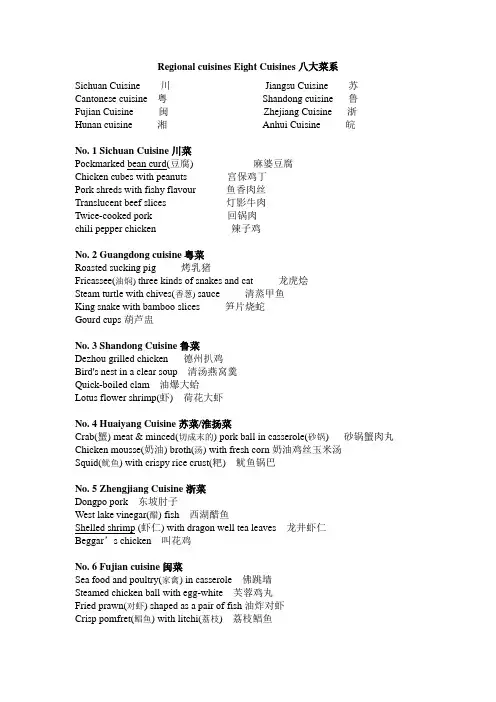
Regional cuisines Eight Cuisines八大菜系Sichuan Cuisine 川Jiangsu Cuisine 苏Cantonese cuisine 粤Shandong cuisine 鲁Fujian Cuisine 闽Zhejiang Cuisine 浙Hunan cuisine 湘Anhui Cuisine 皖No. 1 Sichuan Cuisine川菜Pockmarked bean curd(豆腐) 麻婆豆腐Chicken cubes with peanuts 宫保鸡丁Pork shreds with fishy flavour 鱼香肉丝Translucent beef slices 灯影牛肉Twice-cooked pork 回锅肉chili pepper chicken 辣子鸡No. 2 Guangdong cuisine粤菜Roasted sucking pig 烤乳猪Fricassee(油焖) three kinds of snakes and cat 龙虎烩Steam turtle with chives(香葱) sauce 清蒸甲鱼King snake with bamboo slices 笋片烧蛇Gourd cups葫芦盅No. 3 Shandong Cuisine鲁菜Dezhou grilled chicken 德州扒鸡Bird's nest in a clear soup 清汤燕窝羹Quick-boiled clam 油爆大蛤Lotus flower shrimp(虾) 荷花大虾No. 4 Huaiyang Cuisine苏菜/淮扬菜Crab(蟹) meat & minced(切成末的) pork ball in casserole(砂锅) 砂锅蟹肉丸Chicken mousse(奶油) broth(汤) with fresh corn奶油鸡丝玉米汤Squid(鱿鱼) with crispy rice crust(粑) 鱿鱼锅巴No. 5 Zhengjiang Cuisine浙菜Dongpo pork 东坡肘子West lake vinegar(醋) fish 西湖醋鱼Shelled shrimp (虾仁) with dragon well tea leaves 龙井虾仁Beggar’s chicken 叫花鸡No. 6 Fujian cuisine闽菜Sea food and poultry(家禽) in casserole 佛跳墙Steamed chicken ball with egg-white 芙蓉鸡丸Fried prawn(对虾) shaped as a pair of fish油炸对虾Crisp pomfret(鲳鱼) with litchi(荔枝) 荔枝鲳鱼No.7 Hunan Cuisine湘菜Dongan chicken 东安鸡Braised dried(红烧) pork with eel(鳗鱼) slices 红烧肉Steamed turtle 清蒸甲鱼Spring chicken with cayenne(红椒) pepper 麻辣仔鸡No. 8 Anhui Cuisine皖菜/徽菜Huangshan stewed pigeon 黄山醉鸽Gourd duck葫芦鸭Fricassee(油焖) pork sinew(腱) with egg white蛋花炖肉Crisp pork with pine nuts(松仁) 松仁排骨Other regional cuisine:其它菜系Hot pots /Chongqing hotpot 重庆火锅Muslim cuisine 清真菜Imperial-Simulating(仿皇室的) cuisine 仿膳菜Vegetarian cuisine素菜Northeastern cuisine东北菜Taiwan snack台湾小吃Famous delicacy:名菜北京烤鸭Beijing duck羊肉串Kebab狗不理包子Goubuli steamed stuffed bun; dumb dog dumpling过桥米线Crosses the bridge rice-flour noodle担担面dan dan mian (noodles in spicy garlic sauce)夫妻肺片Fuqi ox lung slice红烧蹄筋braised tendon with brown sauce麻婆豆腐Mapo bean curd西湖醋鱼West Lake sour and sweet fish水煮肉片stewed pork slices东坡肘子pork joint cooked in Su Dongpo's style鱼香肉丝shredded pork in fish flavored sauceStaple主食The staple food of Chinese is rice and flour. Southerners prefer rice and ground rice products, such as cooked rice, New Year rice cake, eight treasure rice pudding, and rice dumpling while northerners prefer cooked wheaten food. With wheat flour, they make steamed bread, stuffed bun, various kinds of noodles, and meat dumpling, etc.译文:中国人的主食以大米和面为主,南方人多吃大米和米粉制品,如米饭、年糕、八宝饭、汤圆。
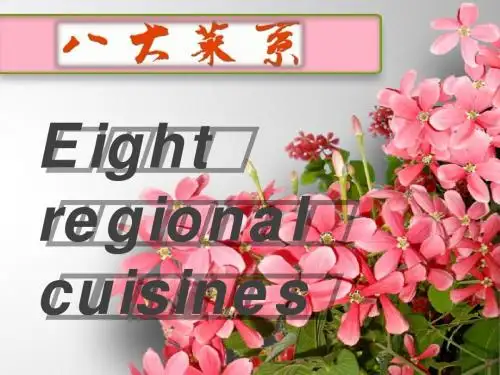
中国八大菜系英文翻译,全部都是干货,赶紧收藏起来↓↓↓点击下方卡片,发现更多精彩↓↓↓英语口语· 吉米老师说最全英文菜名翻译,一篇搞定200个常用单词!英语·食物部分素材来源:跨文化交流研究中心(ID:gkccrc)中国传统餐饮文化历史悠久,菜肴在烹饪中有许多流派,逐渐形成了中国的“八大菜系” (The Eight Traditional Chinese Cuisines) ,即:鲁菜 Shandong Cuisine川菜 Sichuan Cuisine粤菜 Guangdong/Cantonese Cuisine苏菜 Jiangsu Cuisine闽菜 Fujian Cuisine浙菜 Zhejiang Cuisine湘菜 Hunan Cuisine徽菜 Anhui Cuisine鲁菜Shandong Cuisine山东菜系,清淡,不油腻,以其香,鲜,酥,软而闻名。
Shandong cuisine/Confucian cuisine, clear, pure, and not greasy, is characterized by its emphasis on aroma, freshness, crispness and tenderness.常使用青葱(shallot) 和大蒜(garlic) 作为调料。
鲁菜注重汤品。
清汤清澈新鲜,而油汤外观厚重,味道浓重。
Soups are given much emphasis in Shandong cuisine. Its soup features clear and fresh while creamy soup looks thick and tastes strong.Notearoma 芳香 n.crisp 脆的 adj.葱烧海参Sea Cucumber Braised with Scallion一品豆腐Steamed Tofu Stuffed with Vegetables川菜Sichuan Cuisine四川菜系(Sichuan cuisine / Szechuan cuisine) ,是世界上最著名的中国菜系之一。
八大菜系代表菜外文翻译·Shandong Cuisine (鲁菜)Major characteristics of Shandong Cuisine:1) Prepared with a wide variety of materials. For example. Jiaodong dishes are mainly made of aquatic products due to its proximity to the Yellow Sea. People in Jinan and Jiving like to prepare cuisine with mountain delicacies and seafood delights, melons, fruits, vegetables and peppers.2) A pure, strong and mellow taste, rather than a mixed taste. Chefs are good at using onions and seasonings.3) Shandong Cuisine is known for its excellent seafood dishes and delicious soup.4) Chefs excel at preparing clear, smell, crisp, tender and delicious dishes by frying, stirring and steaming.Famous dishes: Stir Fried Prawns, Fried Sea Cucumbers with Onions, Sweet and Sour Carp, Large Jiaodong Chicken Wings, Taishan Fish with Red Scales, etc.·Sichuan Cuisine (川菜)The main- characteristics of Sichuan Cuisine:1) Prepared with a wide variety of ingredients.2) Presenting various shapes and tastes, and famous for spicy food, fish-flavored shredded pork and food with odd taste.3) Boasting numerous cooking techniques, such as stir frying, frying, stir-frying before stewing, and braising.Famous dishes: Stir-fried Diced Chicken with Chilli and Peanuts, Stir-fried Bean Curd in Hot Sauce, Fish-flavored Shredded Pork, Rice Crusts and Sliced Pork, Stir-fried Sliced Beef, etc.·Guangdong Cuisine (粤菜)Guangdong Cuisine, one of the main cuisine styles in China, is composed of Guangzhou, Chaozhou and Dongjiang cuisine. With the advantages of all delicacies from all over the country, Guangdong Cuisine has gradually formed its own characteristics - using a wide variety of ingredients, offering food of all tastes, shapes and colors, good at changing, and serving light food in summer and autumn, and strong and mellow food in winter and spring. Guangdong Cuisine features sour, bitter, spicy and delicious tastes with a clear and fragrant smell. Guangdong snacks are peculiar about ingredients, some sweet and some salty, enjoying the reputation of "100 kinds of snacks having 100 tastes and 100 shapes." There is an old saying: "Guangdong serves best food in the country." Now we can say: "Guangdong offers delicacies from all over the world."Famous dishes: Fried Bean Curd and Fresh Shrimps, Baiyun Pig‘s Trotters,Roast Piglet with Crisp Skin, Dongjiang Salted Chicken, Refreshing Beef Balls, Taiye Chicken, Fried Jelly Fish, etc.·Fujian Cuisine (闽菜)Fujian Cuisine have the following characteristics:1) Chefs are skilled in the use of a kitchen knife, full of interest.2) The Fujian people are peculiar about soup, which is full of changes.3) A wide variety of seasonings are used, with unique characteristics.4) Dishes are meticulously prepared, refined and graceful.5) Fujian Cuisine is characterized by clear, refreshing, delicious and light tastes, slightly sweet and sour.Typical famous dishes: Monk Jumps over Wall, sea clams in Chicken Soup, Glossy Ganoderma and Jade Cicadas, Litchi Pulp, Fragrant Sliced Snails with a Faint Smell of Distillers‘ Grains, Jadeite Pearl Abalone, Chicken with Distillers‘ Grains, etc. Famous snacks: Fried Oyster, Lightly Fried Dumpling, Clam Cakes, Thousand Layer Cake, Meat Balls, Taiji Smashed Taro. ·Jiangsu Cuisine (苏菜)The main characteristics of Jiangsu cuisine:1) Distinguished for exquisite ingredients, freshness and aliveness.2) High cutting techniques.3) Have a good command of duration and degree of heating and cooking.4) Good at keeping the original taste one particular taste for one dish. All dishes have light, mellow and refreshing tastes. Yangzhou Cuisine is light and elegant; Suzhou Cuisine is slightly sweet; and Wuxi Cuisine is fairly sweet. 5) Pay great attention to soup, which is strong but not greasy, and delicious. Famous dishes: Butterfish in Creamy Juice, Santao Duck, Steamed Large Meatballs, Fragrant and Soft Silverfish, Crystal Pig‘s Trotters, Steamed Hilsa Herring, King Bids Farewell to His Consort, etc. Well-known snacks include Dumplings with Juicy Crab Meat Filling, Noodles in Clear Soup, Jadeite Steamed Dumplings with the Dough Gathered at the Top, etc.·Zhejiang Cuisine (浙菜)Of a large number local cuisine styles, Zhejiang Cuisine occupies an important position and mainly consists of Hangzhou, Ningbo, Shaoxing and Wenzhou cuisine styles, each having its own local characteristics.Hangzhou Cuisine, the representative of Zhejiang Cuisine, is delicious, light, crisp, elegant and highly finished. Ningbo local dishes are delicious, tender, soft and refreshing. Shaoxing Cuisine, which has the characteristics of the I,md of fish, includes various kinds of local dishes, which are soft and aromatic with original soup ,[lid juice, light oil, and a heavy taste. Chefs are forbidden to use peppers. Wenzhou Cuisine, also I,nown as On Cuisine, is known for delicious seafood and light and delicious dishes.Famous dishes: West Lake Sour Fish, Dongpo Pork, Longjing Shrimp Meat,Jiaohua Young Chickens, Steam Rice Flower and Pork Wrapped by Lotus Leaves, Braised Bamboo Shoots and Whitefish with Fermented Glutinous Rice.·Hunan Cuisine (湘菜)Hunan Cuisine has three characteristics:1) Skilful use of a kitchen knife, a delicious taste and a beautiful shape.2) Known for sour and spicy dishes by adding various kinds of seasonings.3) Adopting a wide variety of techniques.Famous dishes: Spicy Young Chicken, Fried Fish Slices, Steamed Soft-Shell Turtle, Steamed Cured Meat, Huofang Whitebait, Dongting Fat Fish Maw, Jishou Sour Meat, Oily and Spicy Tender Bamboo Shoots, and Chinese Chestnuts and Hearts of Cabbages.·Anhui Cuisine (徽菜)Anhui Cuisine has the following four characteristics:1) Using a wide variety of ingredients.2) Adopting unique techniques.3) Paying great attention to nutritious food.4) Offering various kinds of dishes, some of which are full of local flavor. Famous dishes: Milky Fat Fish King, Stewed Mati Soft-shelled Turtle in Clear Soup, Guest Welcoming Pine, Crucian Carp in Earthen Pot, Fuliji Chicken, Red Bayberry and Glutinous Rice Balls, etc. Local snacks include Butterfly Noodles, White Gourd Dumplings, Frozen Rice Sugar, Tunxi Liquor-saturated Crabs, etc.。
中国八大菜系英文介绍China covers a large territory and has many nationalities, hence a variety of Chinese food with different but fantastic and mouthwatering flavor. Since China's local dishes have their own typical characteristics, generally, Chinese food can be roughly divided into eight regional cuisines, which has been widely accepted around. Certainly, there are many other local cuisines that are famous, such as Beijing Cuisine and Shanghai Cuisine.Well, due to not that familiar with Chinese history and culture, in the process of translation, there still have been various problems.Therefore,our group aims at picking out some typicals in translating the eight major cuisines of China .Through the gathering of both information and pictures, next,we're going to show you the translation of the eight major cuisines of China .Ⅰ.Shandong Cuisine山东菜系Consisting of Jinan cuisine and Jiaodong cuisine, Shandong cuisine, clear, pure and not greasy, is characterized by its emphasis on aroma, freshness, crispness and tenderness. Shallot and garlic are usually used as seasonings so Shangdong dishes tastes pungent usually. Soups are given much emphasis in Shangdong dishes. Thin soup features clear and fresh while creamy soup looks thick and tastes strong. Jinan cuisine is adept at deep-frying, grilling, frying and stir-frying while Jiaodong division is famous for cooking seafood with fresh and light taste.德州扒鸡Dezhou Braised Chicken糖醋鲤鱼Carp in Sweet and Sour Sauce辣子全鸡Spicy chicken whole爆炒腰花 Quickly Fried Pig Kidney(saute kidney)清汤柳叶燕菜Stewed Swiflets Nest一品豆腐“Yiping”Bean Curd炸蚕蛹鸡Fried “Silkworm Pupa” Chicken红烧鱼唇Fried Fish Lip in Brown SauceⅡ.Sichuan Cuisine四川菜系Sichuan Cuisine, known often in the West as Szechuan Cuisine, is one of the most famous Chinese cuisines in the world. Characterized by its spicy and pungent flavor, Sichuan cuisine, prolific of tastes, emphasizes on the use of chili. Pepper and prickly ash also never fail to accompany, producing typical exciting tastes. Besides, garlic, ginger and fermented soybean are also used in the cooking process. Wild vegetables and animals are usually chosen as ingredients, while frying, frying without oil, pickling and braising are applied as basic cooking techniques.宫保鸡球Kung Pao Chicken四川牛肉Szechuan Beef麻婆豆腐mapo tofu四川虾Szechuan Prawns鱼香茄子Braised Egg plant回锅肉Twice cooked pork宫保鸡丁Kung Pao Chicken鱼香肉丝Fish Flavored porkⅢ.Guangdong Cuisine广东菜系Cantonese food originates from Guangdong, the southernmost province in China. The majority of overseas Chinese people are from Guangdong (Canton)so Cantonese is perhaps the most widely available Chinese regional cuisine outside of China.炸子鸡Braised crispy chicken刨冰Various dessert drinks served with shaved ice鲜虾云吞面Shrimp wonton noodle soup叉烧Char shiu咖哩猪皮Pork rind curry蒸咸鱼Salted preserved fish焖鲍鱼Braised dried abalone云腿鸡片stir-fried chicken and ham花枝羹Squid thick soup港式奶茶Black tea with condensed milkⅣ.Fujian Cuisine福建菜系Consisting of Fuzhou Cuisine, Quanzhou Cuisine and Xiamen Cuisine, Fujian Cuisine is distinguished for its choice seafood, beautiful color and magic taste of sweet, sour, salty and savory. The most distinct features are their "pickled taste".白切海螺Boiled Whelk Meat Slices银耳羹White Fungus Thick soup红烧大鲍翅Fried Ormer Fin in Brown Sauce佛跳墙Buddha Jumps over the Wall闽生果Min fruit梅开二度Secondbloom盐水虾Brine shrimp醉排骨Drunken ribs炸蛎黄Fried oysterJiangsu Cuisine, also called Huaiyang Cuisine, is popular in the lower reach of the Yangtze River. Aquatics as the main ingredients, it stresses the freshness of materials. Its carving techniques are delicate, of which the melon carving technique is especially well known. Cooking techniques consist of stewing, braising, roasting, simmering, etc. The flavor of Huaiyang Cuisine is light, fresh and sweet and with delicate elegance. Jiangsu cuisine is well known for its careful selection of ingredients, its meticulous preparation methodology, and its not-too-spicy, not-too-bland taste. Since the seasons vary in climate considerably in Jiangsu, the cuisine also varies throughout the year. If the flavor is strong, it isn't too heavy; if light, not too bland.松鼠桂鱼:Sweet and Sour Mandarin Fish三套鸭:Three-nested Duck清炖蟹粉狮子头:Pork balls霸王别姬:Farewell to My Concubine梁王鱼Liangwang fish糖醋排骨Braised Spareribs栗子闷鸡肉Chestnut and Chicken Stew鸭血粉丝汤Duck blood and bean-starchy vermicelli soupComprising local cuisines of Hangzhou, Ningbo and Shaoxing, Zhejiang Cuisine, not greasy, wins its reputation for freshness, tenderness, softness, smoothness of its dishes with mellow fragrance. Hangzhou Cuisine is the most famous one among the three.冰糖甲鱼Steamed Turtle in Crystal Sugar Soup宁氏鳝丝Eel silk东坡肉Dongpo pork西湖醋鱼West lake fish in vinegar sauce叫花鸡Beggar's chicken龙井虾仁Fried shrimps with longjing tea干菜焖肉Dry vegetable braised with meatHunan cuisine consists of local Cuisines of Xiangjiang Region, Dongting Lake and Xiangxi coteau. It characterizes itself by thick and pungent flavor. Chili, pepper and shallot are usually necessaries in this division.组庵鱼翅Zuyan Shark's Fin冰糖湘莲Sugar Candy Lotus东安子鸡Dong Zi An Chicken葱爆肉丁Sliced pork with scallion脆皮三丝卷Crisp rolls of pork,sea-cucumber and bamboo shoots冬菜扣肉Steamed spicy cabbage abd pork古老肉Sweet-and-sour pork滑肉片Sliced prok with cream sauceAnhui Cuisine chefs focus much more attention on the temperature in cooking and are good at braising and stewing. Often hams will be added to improve taste and sugar candy added to gain清炖马蹄鳖:Stewed Turtle李鸿章杂烩Li Hongzhang Assorted Dish符离集烧鸡Fuliji Braised Chicken焖牛肉pot roast beef清炸猪里脊dry-fried pork fillet砂锅狮子头meatballs in earthen-pot水晶蹄膀shredded pork knuckle in jelly蜜汁红芋Red Tato in Honey。
∙中国八大菜系t h e e i g h t m a j o r c u i s i n e s o f C h i n a∙中餐烹饪的独特艺术t h e d i s t i n c t i v e C h i n e s e c u l i n a r y a r t∙“烹饪王国”“t h e k i n g d o m o f c u i s i n e”∙中餐注重选料,精于刀工,善于炊技C h i n e s e c u i s i n e f e a t u r e s c a r e f u l s e l e c t i o n o f i n g r e d i e n t s,a d e p t t e c h n i q u e i n s l i c i n g a n d p e r f e c tc o o k i n g s k i l l s.∙中国菜讲究“色、香、味”C h i n e s e d i s h e s a r e f a m o u s f o r t h e i r c o l o r,f l a v o r a n d t a s t e.∙南淡北咸,东甜西辣t h e l i g h t s o u t h e r n c u i s i n e,a n d t h e s a l t y n o r t h e r n c u i s i n e;t h e s w e e t e a s t e r n c u i s i n e,a n d t h e s p i c y w e s t e r nc u i s i n e∙原汁原味t h e o r i g i n a l f l a v o r o f t h e c h o s e n m a t e r i a l∙麻辣s p i c y-h o t∙美味佳肴d e l i c a c i e s∙备受青睐t o e n j o y/g a i n p o p u l a r i t y;t o b e p o p u l a r∙烹饪餐具c o o k i n g u t e n s i l∙菜谱r e c i p e/m e n u∙清真菜M u s l i m f o o d∙素食菜v e g e t a r i a n f o o d∙药膳m e d i c a t e d d i e t/h e a l t h f o o d∙家乡/地方风味l o c a l f l a v o r d i s h∙特色/招牌菜t h e c h e f’s r e c o m m e n d a t i o n;s p e c i a l t y∙臭豆腐s t r o n g-s m e l l i n g p r e s e r v e d b e a n c u r d∙豆瓣酱t h i c k b r o a d-b e a n s a u c e∙豆腐干d r i e d b e a n c u r d;d r i e d s o y a b e a n c u r d∙豆腐乳p r e s e r v e d b e a n c u r d∙豆浆s o y b e a n m i l k∙豆腐脑b e a n c u r d j e l l y∙大饼、油条、馒头、煎饼b a n n o c k,t w i s t e d c r u l l e r,s t e a m e d b r e a d/b u n,p a nc a k e∙米饭、炒饭s t e a m e d r i c e,f r i e d r i c e∙小米粥m i l l e t c o n g e e∙芝麻汤圆s w e e t r i c e b a l l s w i t h s o u p∙炒面/汤面/米线s t i r-f r i e d n o o d l e s/s o u p n o o d l e s/r i c e n o o d l e s∙粉丝b e a n s t a r c h v e r m i c e l l i;m u n g b e a n n o o d l e s∙茶叶蛋e g g s t e w e d i n t e a∙皮蛋p r e s e r v e d e g g∙咸蛋s a l t e g g∙草菇老抽m u s h r o o m f l a v o r e d d a r k s o y s a u c e∙生姜g i n g e r∙醋v i n e g a r∙酱油s o y s a u c e∙豆豉b l a c k b e a n∙番茄酱t o m a t o s a u c e/t o m a t o p a s t e∙咖喱粉c u r r y p o w d e r∙花生酱p e a n u t b u t t e r∙卤水b r i n e∙小磨香油g r o u n d s e s a m e s e e d∙镇江香醋Z h e n j i a n g v i n e g a r∙黄酒y e l l o w r i c e w i n e∙淀粉s t a r c h∙粗粮r o u g h f o o d∙荞麦粉b u c k w h e a t f l o u r∙粳米m o u n t a i n r i c e;r o u n d-s h a p e d r i c e∙毛豆y o u n g s o y b e a n∙刀豆s w o r d b e a n∙荠菜S h e p h e r d’s p u r s e∙茭白w i l d r i c e s t e m/w a t e r o a t∙笋b a m b o o s h o o t s∙芦笋a s p a r a g u s∙对虾/明虾p r a w n∙龙虾l o b s t e r∙海参s e a c u c u m b e r∙鱿鱼s q u i d∙乌贼c u t t l e f i s h∙鲈鱼b a s s∙三文鱼刺身s a l m o n s a s h i m i∙大黄鱼l a r g e y e l l o w f i s h∙苏眉鱼S u m e i f i s h∙辣味炸子鸡f r i e d y o u n g c h i c k e n(s l i g h t l y c h i l i f l a v o r e d)∙茄汁沙丁鱼s a r d i n e i n t o m a t o s a u c e∙油焖笋b r a i s e d b a m b o o s h o o t∙走油肉d e-f a t t e d p o r k∙清炒河虾仁s t i r-f r i e d s h e l l e d s h r i m p s∙吉利牛排b e e f c u t l e t s∙桂花糖藕l o t u s w i t h s u g a r∙极品大网鲍鱼s u p e r i o r a b a l o n e∙毛蟹炒年糕f r i e d c r a b s w i t h N e w Y e a r c a k e m a d e o f g l u t i n o u s r i c e ∙麻婆豆腐b r a i s e d b e a n c u r d w i t h m i n c e d p o r k(S i c h u a n s t y l e)∙鲜肉云吞b o i l e d f r e s h m e a t w o n t o n∙春卷s p r i n g r o l l∙叉烧包s t e a m e d b u n f i l l e d w i t h r o a s t p o r k∙酥皮鸡蛋挞b a k e d e g g c u s t a r d t a r t∙奶油太妃糖c r e a m t o f f e e∙人参软糖g i n s e n g j e l l y∙脱脂牛奶s k i m m e d m i l k∙奶油芝士酥c r e a m c h e e s e b i s c u i t∙百威啤酒B u d w e i s e r b e e r∙冰镇啤酒i c e d b e e r∙薄荷烧酒p e p p e r m i n t s p i r i t∙果酒f r u i t w i n e∙皇冠伏特加S m i r n o f f V o d k a∙蓝带马爹利M a r t e l l C o r d o n B l e u∙拿破仑X.O.C o u r v o i s i e r X.O.∙茅台酒m a o t a i∙绍兴酒S h a o x i n g r i c e w i n e∙山西汾酒S h a n x i F e n J i u∙矿泉水m i n e r a l w a t e r∙苏打水s o d a w a t e r∙香槟酒c h a m p a g n e∙威士忌w h i s k y∙白兰地b r a n d y∙鸡尾酒c o c k t a i l∙款待t o e n t e r t a i n…;t o e x t e n d k i n d/c o r d i a l h o s p i t a l i t y t o…∙工作午餐w o r k i n g/b u s i n e s s l u n c h e o n∙冷餐招待会b u f f e t r e c e p t i o n∙西餐W e s t e r n f o o d∙欧式早餐C o n t i n e n t a l b r e a k f a s t∙方便食品j u n k f o o d∙不含防腐剂f r e e o f p r e s e r v a t i v e∙不放味精t o c o n t a i n n o g o u r m e t p o w d e r∙去壳s h e l l i n g∙去骨b o n i n g∙去皮s k i n n i n g/p e e l i n g∙刮鳞s c a l i n g∙燎毛s i n g l i n g∙切片/丝/柳/丁s l i c i n g/s h r e d d i n g/f i l l e t i n g/d i c i n g∙切条/段c u t i t i n t o1-i n c h s t r a p s/c h u n k s∙煎/炒/爆/炸p a n/s t i r/q u i c k/d e e p-f r y i n g∙铁扒g r i l l i n g;b r o i l i n g∙清蒸s t e a m i n g∙红烧b r a i s i n g w i t h s o y s a u c e/b r o w n s a u c e s c a l d i n g∙白灼s c a l d i n g∙摆席s e t t h e t a b l e∙开胃品a p p e t i z e r∙甜食d e s s e r t∙主菜m a i n c o u r s e∙(不含酒精)饮料s o f t d r i n k∙沏/泡/品/喝茶t o m a k e/b r e w/s i p/d r i n k t e a∙粘牙s t i c k t o o n e’s t e e t h∙剔牙p i c k o n e’s t e e t h∙快餐店s n a c k b a r∙路旁餐馆d r i v e-i n∙小酒店(英国)p u b∙小食店(法国)b r a s s e r i e∙各人自付g o D u t c h∙请别客气m a k e y o u r s e l f a t h o m e∙请常常我的拿手菜W o u l d y o u l i k e t o t r y m y s p e c i a l r e c i p e?∙你想点菜吗?A r e y o u r e a d y t o o r d e r,s i r?∙你们有一张两人用餐的桌子吗?H a v e y o u g o t a t a b l e f o r t w o?。
八大菜系代表菜外文翻译·Shandong Cuisine (鲁菜)Major characteristics of Shandong Cuisine:1) Prepared with a wide variety of materials. For example. Jiaodong dishes are mainly made of aquatic products due to its proximity to the Yellow Sea. People in Jinan and Jiving like to prepare cuisine with mountain delicacies and seafood delights, melons, fruits, vegetables and peppers.2) A pure, strong and mellow taste, rather than a mixed taste. Chefs are good at using onions and seasonings.3) Shandong Cuisine is known for its excellent seafood dishes and delicious soup.4) Chefs excel at preparing clear, smell, crisp, tender and delicious dishes by frying, stirring and steaming.Famous dishes: Stir Fried Prawns, Fried Sea Cucumbers with Onions, Sweet and Sour Carp, Large Jiaodong Chicken Wings, Taishan Fish with Red Scales, etc.·Sichuan Cuisine (川菜)The main- characteristics of Sichuan Cuisine:1) Prepared with a wide variety of ingredients.2) Presenting various shapes and tastes, and famous for spicy food, fish-flavored shredded pork and food with odd taste.3) Boasting numerous cooking techniques, such as stir frying, frying, stir-frying before stewing, and braising.Famous dishes: Stir-fried Diced Chicken with Chilli and Peanuts, Stir-fried Bean Curd in Hot Sauce, Fish-flavored Shredded Pork, Rice Crusts and Sliced Pork, Stir-fried Sliced Beef, etc.·Guangdong Cuisine (粤菜)Guangdong Cuisine, one of the main cuisine styles in China, is composed of Guangzhou, Chaozhou and Dongjiang cuisine. With the advantages of all delicacies from all over the country, Guangdong Cuisine has gradually formed its own characteristics - using a wide variety of ingredients, offering food of all tastes, shapes and colors, good at changing, and serving light food in summer and autumn, and strong and mellow food in winter and spring. Guangdong Cuisine features sour, bitter, spicy and delicious tastes with a clear and fragrant smell. Guangdong snacks are peculiar about ingredients, some sweet and some salty, enjoying the reputation of "100 kinds of snacks having 100 tastes and 100 shapes." There is an old saying: "Guangdong serves best food in the country." Now we can say: "Guangdong offers delicacies from all over the world."Famous dishes: Fried Bean Curd and Fresh Shrimps, Baiyun Pig‘s Trotters,Roast Piglet with Crisp Skin, Dongjiang Salted Chicken, Refreshing Beef Balls, Taiye Chicken, Fried Jelly Fish, etc.·Fujian Cuisine (闽菜)Fujian Cuisine have the following characteristics:1) Chefs are skilled in the use of a kitchen knife, full of interest.2) The Fujian people are peculiar about soup, which is full of changes.3) A wide variety of seasonings are used, with unique characteristics.4) Dishes are meticulously prepared, refined and graceful.5) Fujian Cuisine is characterized by clear, refreshing, delicious and light tastes, slightly sweet and sour.Typical famous dishes: Monk Jumps over Wall, sea clams in Chicken Soup, Glossy Ganoderma and Jade Cicadas, Litchi Pulp, Fragrant Sliced Snails with a Faint Smell of Distillers‘ Grains, Jadeite Pearl Abalone, Chicken with Distillers‘ Grains, etc. Famous snacks: Fried Oyster, Lightly Fried Dumpling, Clam Cakes, Thousand Layer Cake, Meat Balls, Taiji Smashed Taro. ·Jiangsu Cuisine (苏菜)The main characteristics of Jiangsu cuisine:1) Distinguished for exquisite ingredients, freshness and aliveness.2) High cutting techniques.3) Have a good command of duration and degree of heating and cooking.4) Good at keeping the original taste one particular taste for one dish. All dishes have light, mellow and refreshing tastes. Yangzhou Cuisine is light and elegant; Suzhou Cuisine is slightly sweet; and Wuxi Cuisine is fairly sweet. 5) Pay great attention to soup, which is strong but not greasy, and delicious. Famous dishes: Butterfish in Creamy Juice, Santao Duck, Steamed Large Meatballs, Fragrant and Soft Silverfish, Crystal Pig‘s Trotters, Steamed Hilsa Herring, King Bids Farewell to His Consort, etc. Well-known snacks include Dumplings with Juicy Crab Meat Filling, Noodles in Clear Soup, Jadeite Steamed Dumplings with the Dough Gathered at the Top, etc.·Zhejiang Cuisine (浙菜)Of a large number local cuisine styles, Zhejiang Cuisine occupies an important position and mainly consists of Hangzhou, Ningbo, Shaoxing and Wenzhou cuisine styles, each having its own local characteristics.Hangzhou Cuisine, the representative of Zhejiang Cuisine, is delicious, light, crisp, elegant and highly finished. Ningbo local dishes are delicious, tender, soft and refreshing. Shaoxing Cuisine, which has the characteristics of the I,md of fish, includes various kinds of local dishes, which are soft and aromatic with original soup ,[lid juice, light oil, and a heavy taste. Chefs are forbidden to use peppers. Wenzhou Cuisine, also I,nown as On Cuisine, is known for delicious seafood and light and delicious dishes.Famous dishes: West Lake Sour Fish, Dongpo Pork, Longjing Shrimp Meat,Jiaohua Young Chickens, Steam Rice Flower and Pork Wrapped by Lotus Leaves, Braised Bamboo Shoots and Whitefish with Fermented Glutinous Rice.·Hunan Cuisine (湘菜)Hunan Cuisine has three characteristics:1) Skilful use of a kitchen knife, a delicious taste and a beautiful shape.2) Known for sour and spicy dishes by adding various kinds of seasonings.3) Adopting a wide variety of techniques.Famous dishes: Spicy Young Chicken, Fried Fish Slices, Steamed Soft-Shell Turtle, Steamed Cured Meat, Huofang Whitebait, Dongting Fat Fish Maw, Jishou Sour Meat, Oily and Spicy Tender Bamboo Shoots, and Chinese Chestnuts and Hearts of Cabbages.·Anhui Cuisine (徽菜)Anhui Cuisine has the following four characteristics:1) Using a wide variety of ingredients.2) Adopting unique techniques.3) Paying great attention to nutritious food.4) Offering various kinds of dishes, some of which are full of local flavor. Famous dishes: Milky Fat Fish King, Stewed Mati Soft-shelled Turtle in Clear Soup, Guest Welcoming Pine, Crucian Carp in Earthen Pot, Fuliji Chicken, Red Bayberry and Glutinous Rice Balls, etc. Local snacks include Butterfly Noodles, White Gourd Dumplings, Frozen Rice Sugar, Tunxi Liquor-saturated Crabs, etc.。